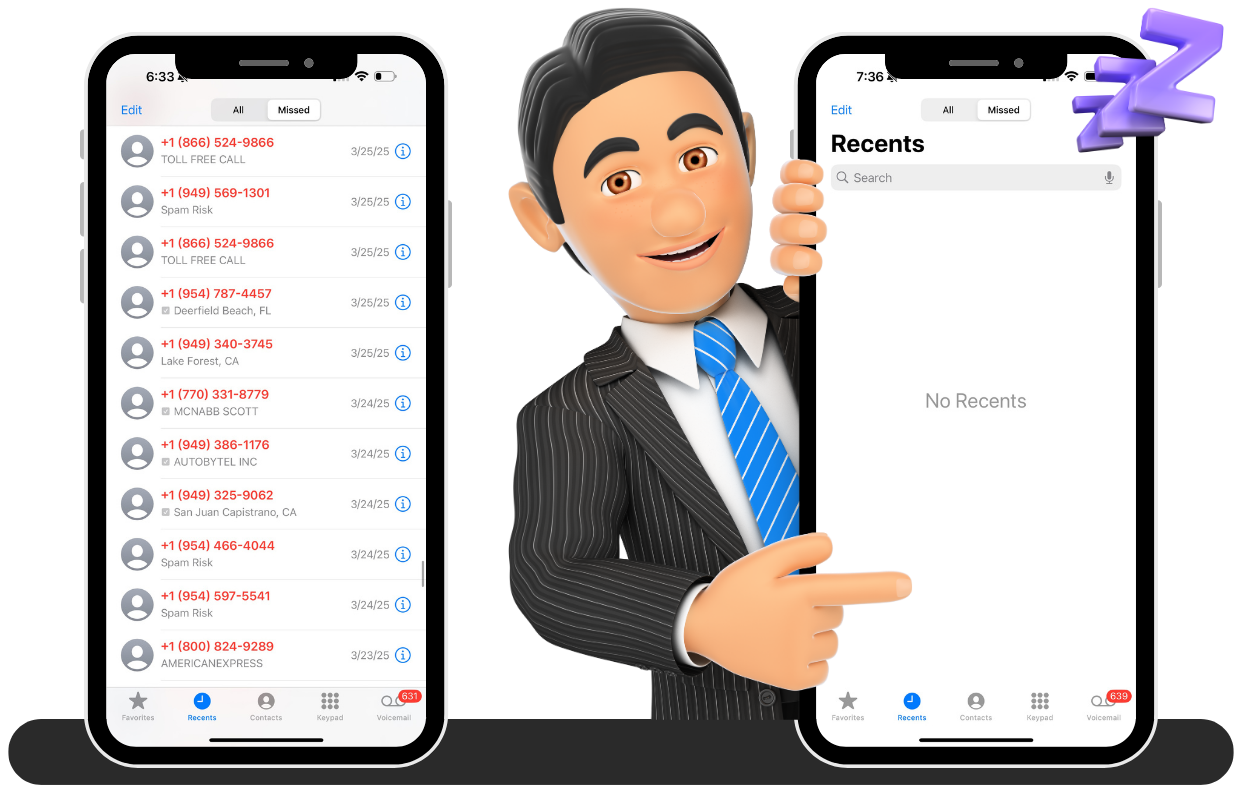"Can I really SUE these people?"
Yes. And you should.
Look, I get it. The word "lawsuit" sounds intimidating. Expensive. Time-consuming. Only for people who wear suits and say "objection!"
But here's the truth: Suing robocallers is actually EASIER than most legal actions. Why?
- • The law is crystal clear (either they called illegally or they didn't)
- • Damages are pre-set ($500-$1,500 per call)
- • Evidence is digital and indisputable
- • Companies almost always settle (they know they're guilty)
- • Lawyers work on contingency (no upfront cost)
Let me walk you through exactly how this works...
Option 1: Small Claims Court (The DIY Route)
Small claims is perfect for cases with fewer violations. Most states allow claims up to $5,000-$10,000.
Step 1: Gather Your Evidence
You'll need:
- • Call logs with dates and times
- • Caller ID screenshots or records
- • Voicemail recordings (if any)
- • Proof you're on the Do Not Call Registry
- • Documentation that you asked them to stop
Step 2: Identify the Defendant
This is the hard part. You need the actual company name and address. Not just a phone number.
DNCme's tech solves this problem by tracing calls back to their source.
Step 3: File Your Claim
Go to your local small claims court, fill out the forms, pay the filing fee ($30-$100 typically), and serve the defendant.
Step 4: Show Up to Court
Present your evidence to the judge. Explain the TCPA violations. Most judges LOVE these cases because the law is so clear.
Reality Check: About 70% of defendants don't even show up to small claims court, which means you win by default!
Option 2: Federal Court (The Big Leagues)
For cases with multiple violations worth more than small claims limits, you file in federal court.
Pros:
- • No dollar limit on claims
- • More discovery tools available
- • Stronger enforcement of judgments
- • Can recover legal fees if you win
Cons:
- • More complex procedures
- • Definitely need a lawyer
- • Takes longer (6-12 months typically)
When to Choose Federal Court:
- • You have 20+ documented violations
- • Total potential recovery exceeds $10,000
- • Defendant is a large company with deep pockets
- • You have a strong case for willful violations ($1,500 each)
Option 3: Settlement Demand Letter (The Smart Play)
Here's what MOST successful TCPA claimants actually do:
They skip court entirely and send a settlement demand letter.
Why This Works:
Companies know they violated the law. They know they'll lose in court. They know court costs MORE than settling.
So when faced with solid evidence and a reasonable settlement demand, they usually just pay up.
What Goes in a Demand Letter:
- • Your contact information
- • Summary of violations (dates, times, call details)
- • Legal basis (cite the TCPA, 47 U.S.C. § 227)
- • Damages calculation ($500 x number of calls)
- • Settlement demand (usually 60-70% of max damages)
- • Deadline to respond (typically 30 days)
- • Warning that you'll file suit if they don't settle
Sample Settlement Demand (Simplified):
"Dear [Company],
Between January 1, 2025 and March 15, 2025, your company called my cell phone 47 times despite the fact that:
- • My number has been on the National Do Not Call Registry since 2020
- • I explicitly requested removal from your call list on January 5, 2025
- • I never provided written consent to receive automated calls
These calls violate the Telephone Consumer Protection Act, 47 U.S.C. § 227. Each violation carries statutory damages of $500-$1,500.
I am willing to settle this matter for $28,200 (47 calls × $600 per call) if payment is received within 30 days.
Otherwise, I will file suit in [Federal District Court] and pursue full statutory damages of $70,500, plus legal fees and court costs.
Sincerely,
[Your name]"
Success Rate: About 85% of well-documented demand letters result in settlement offers.
Real Lawsuit Examples (What Actually Happens):
Case Study #1: The Car Warranty Settlement
DNCme member Sarah documented 63 car warranty robocalls over 3 months. Our legal network sent a demand letter asking for $37,800.
Company response: Settlement offer of $31,500 within 2 weeks.
Sarah's net (after legal fees): $22,050.
Court appearances: Zero.
Case Study #2: The Small Claims Victory
Member Tom had 8 documented violations from a solar panel company. He filed in small claims court himself (no lawyer).
Company didn't show up to court. Judge awarded $4,800 by default.
Total cost to Tom: $75 filing fee.
Time investment: 4 hours.
Return on investment: 6,300%.
Case Study #3: The Federal Court Jackpot
Member Lisa had 127 violations from a debt collector. Filed in federal court with a TCPA specialist.
Company tried to fight. Bad move. Judge found willful violations ($1,500 each).
Total judgment: $190,500.
After legal fees: Lisa netted $133,350.
Time: 8 months from filing to payment.
Common Objections (And Why They're Wrong):
"I can't afford a lawyer."
TCPA lawyers work on contingency. They only get paid if you win. No upfront costs.
"They'll just ignore me."
If they ignore your demand letter, you file suit. If they ignore the lawsuit, you get a default judgment. They can't win by ignoring you.
"They'll countersue me."
For what? Answering your phone? This literally never happens in TCPA cases. They have no legal basis to sue YOU.
"The legal system is rigged for big companies."
Not for TCPA cases. The law is SO clear and damages SO specific that big companies actually LOSE this fight regularly.
"I'll get blacklisted."
Good! That's the point! Getting flagged as "litigious" makes robocallers STOP calling you. Mission accomplished.
The DNCme Advantage:
You CAN do this alone. But you'll be more successful with help:
- • Automated evidence collection - No manual call logs needed
- • Caller identification technology - We find the real company behind spoofed numbers
- • Network of TCPA specialists - Lawyers who WIN these cases
- • Pre-written demand letter templates - Proven to get settlements
- • Case evaluation - We tell you if your case is strong before you file
- • Settlement negotiation - We know what these cases are worth
How to Start Your Lawsuit Today:
Step 1: Stop deleting evidence. Every call is money.
Step 2: Join DNCme to start proper documentation and get access to our legal network.
Step 3: Collect evidence for 60-90 days (more violations = bigger settlement).
Step 4: Get a free case evaluation from our TCPA specialists.
Step 5: Choose your path: demand letter, small claims, or federal court.
Step 6: File, settle, collect.
The Bottom Line on Suing Robocallers:
Is it scary? Maybe at first.
Is it worth it? ABSOLUTELY.
Average settlement: $23,400.
Average time to settlement: 5 months.
Average satisfaction rating from members: 9.7/10.
These companies have been harassing you for free. Time to make them pay for the privilege.
Ready to Sue and Win?
Learn how one call led to $1,500+ wins. Free download of demand letter template for DNCme members.
Stop Robocalls NowP.S. The first lawsuit is always the hardest. After that? You'll wonder why you waited so long. One member called it "the most satisfying legal action I've ever taken."
P.P.S. These companies count on you being too intimidated to sue. Don't give them that satisfaction. Hold telemarketers accountable for violations.
*Legal Disclaimer: All claims regarding potential settlements, damages, or legal outcomes are hypothetical and for educational purposes only. DNCME is not a law firm and does not provide legal advice. We connect consumers with qualified attorneys in our network who specialize in TCPA violations. Actual results may vary and depend on individual circumstances, evidence quality, and legal representation. Past results do not guarantee future outcomes. Consult with a licensed attorney for advice regarding your specific situation.

